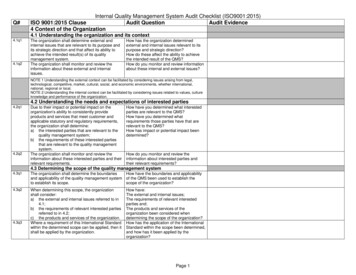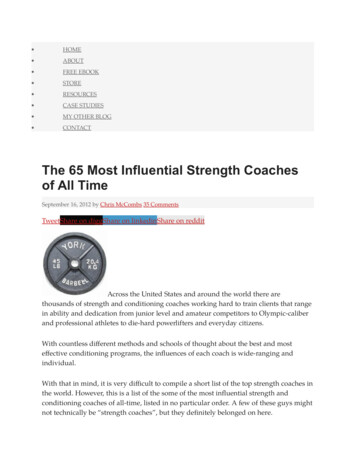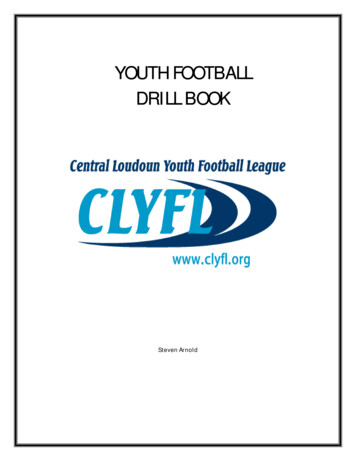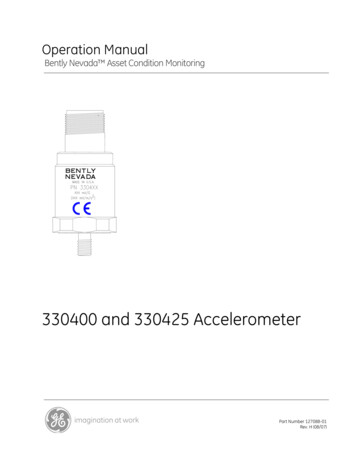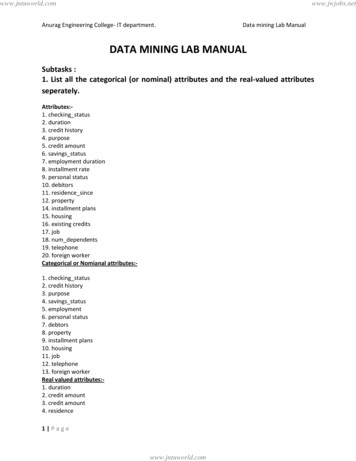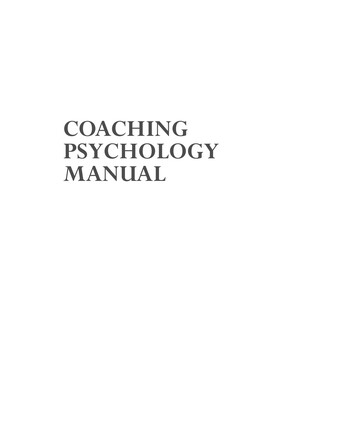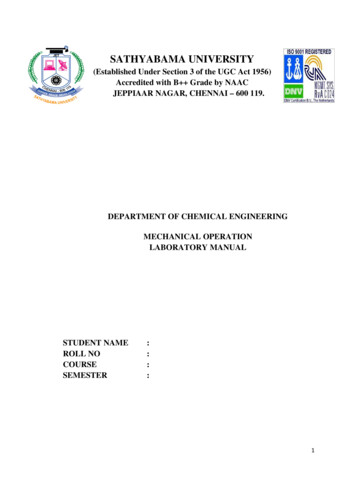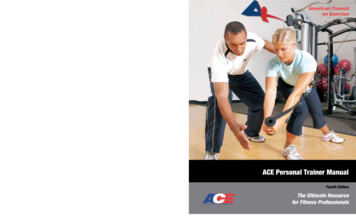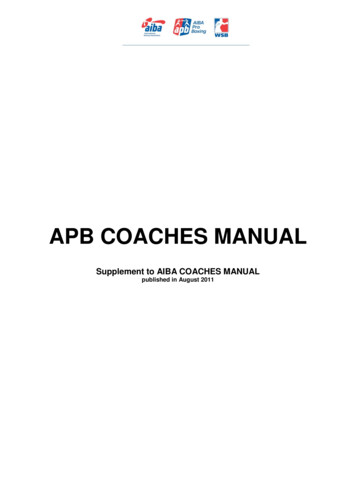
Transcription
APB COACHES MANUALSupplement to AIBA COACHES MANUALpublished in August 2011
FOREWORDAIBA Professional Boxing Coaches Manual is designed as an addition to AIBA CoachesManual helping the coach understand the fundamentals of AIBA Professional Boxing.The AIBA Professional Boxing Coaches Manual assists coaches’ development andenhances the qualities in coaching providing the coach with the knowledge and personalskills to manage a successful career in AIBA Professional Boxing.AIBA Coaches Commission2
TABLE OF CONTENTSFOREWORD . 2Part 1.About coaching in APB . 51.1.Definition of Boxer in APB . 51.2.Difference between AOB and APB , coaching aspects . 61.3.What is fundamental in APB . 7Part 2.Coach in APB . 82.1. The role of the coach in APB . 82.2. Responsibility before, during and after the competition . 82.2.1. Role of the coach in APB . 82.2.2. Role of the Second. 92.2.3. Role of the Cutman . 10Part 3.Structure of Training Process in APB . 123.1. Training Planning. 123.2. Training plan example of Week 4 (Week 2 of the Intense Period) . 163.3. Training plan example of Week 9 (2 weeks before competition) . 173.4. Training plan example of Week 10 (1 week before competition) . 183.5. Just before the Competition . 19Part 4.Training methodology . 204.1.10 principles of training . 204.2.General preparation . 214.2.1.Interval training . 214.2.2.Strength and conditioning . 244.3.Specific preparation . 244.3.1.Technical . 244.3.2.Tactical . 254.4.Mental & Psychological Preparation . 263
Sparring in APB . 27Part 5.Medical Aspects . 285.1. Nutrition . 285.1.1. Nutritional facts . 285.1.2. Functions of nutrients . 285.1.3. Energy nutrients . 305.1.4. Balanced diet . 305.1.5. Intake breakdown . 305.1.6. Dehydration. 315.1.7. Weight Making Tips . 315.1.8. After the weigh in . 325.2. Injuries . 335.2.1. Different injuries . 335.3. Injury prevention . 345.4. Treatment of injuries . 345.4.1. Cut . 345.4.2. Hematomas. 355.4.3. Fractures . 36APPENDIX 1 . 37APPENDIX 2 . 38APPENDIX 3 . 39APPENDIX 4 . 404
Part 1.About coaching in APBThe coach has to have the ability and understand the individual capabilities of the boxer inrelationships to his strengths and weaknesses. It is important to identify his weak areas andstrengths and consistently work on them. The coach has the ability to develop the trainingplans as related to each individual boxer. In relationship to this he must to understand whatis good for one may not be good for another.1.1. Definition of Boxer in APB APB is boxer’s occupation and career APB Boxer is someone who trains full time APB Boxer is looking for perfection The main goal of the APB Boxer is to get to the top and to win a Title so he can besuccessful APB Boxer is the boxer who represents his country in the world of Professional Boxing Components of boxer’s performance: Coordination – ability to shift from one kind of movement to a different one, whichdepends on athlete’s body agility Endurance – ability to withstand fatigue Flexibility – range of motion that a joint can be moved Power – application of strength over a period of time Strength – amount of force a muscle can exert Speed – combination of coordination, endurance, flexibility, power Technical skills Tactical skills Mental preparation5
1.2. Difference between AOB and APB , coaching aspectsAOBASPECTTraining in a group and teamAPBIndividual focus-Training-atmosphereShort 3-round bouts -Bout- Longer boutsIntensity ofMultiple bouts in a year -the- Maximum 6 bouts a yearcompetitionsProfessional boxer aims to beThe aim of the boxer is to scorethe points and to win the round by-Goal-delivering clear punches todamage the opponent as wellas winning the roundopponent’s target areasReadiness to fight multiple timesduring a competition/tournament -The way ofpreparationLooksLow risk of severe injuries Knowledge of an opponent and asound game plan gives boxer the iod- More dangerousBoxerismoreconcerned- before the bout due to theduration of the boutrequired confidence-to- opponent more over the longeragainst different opponentsTraining for 4-5 opponents in oneprecise with his punches and- Training for one opponentweekTacticsBecause of the shorter timeframe-Tacticandstrategyhave- been clear as the bout goes onthe tactics are not always cleara longer periodCoach selects a boxer -Coach- Boxer selects a coachProfessional Bandages (seeHeadguards, gloves, bandages-Equipmentand vests-Appendix 1), different kind andsizeofglovesthanAOBglovesJudgesComputerised scoring systemrecording punches onlyScoringscoresonmanualscore cards and evaluate mostof bout components (not onlythe punches)6
1.3. What is fundamental in APB Structured and clear plan of competition The boxer stays within National Federation, therefore receives full support from hisNational Federation, including team (coach, trainer, Cutman, nutritionist, medicaladviser, physiotherapist, psychologist), funding, training facilities, pension plan andhealth insurance. Boxer has the opportunity to train effectively to avoid injury and be successful in hiscareer More motivation for the boxer; financial rewards opportunities for success in theboxer’s career Boxer is comfortable in the structure More fans and spectators, more TV exposure The boxer keeps Olympic Eligibility7
Part 2.Coach in APB2.1. The role of the coach in APBTo provide adequate training and opportunities to improve to his boxer. The goal should beto take the boxer to the highest level.Qualities of a coach: Leadership Technical Knowledge Teaching Ability Communicator Motivator Disciplinarian Physiologist Adaptability to stress Organizer Flexible2.2. Responsibility before, during and after the competition2.2.1. Role of the coach in APB Health and safety of the boxer must be the coach’s first concern always. The coach must seek to form the relationships with the boxer in order to gain hisconfidence and trust. The coach must act in the boxers best interest at all times and advise him correctly. The coach must shield the boxer from any negative influences. To develop a training program for the boxer which will provide him with the properelements technically, physically, tactically and mentally that will make him successful.8
2.2.2. Role of the Second Before the boutoTo get the boxer to the competition venue on time with the correct equipment.oTo make sure that the boxer is fit and ready to compete.oTo make sure that the changing room is a restricted comfortable area for theboxer.oTo make sure he is aware of the time left before the bout by doing frequentchecks in order to prepare the boxer for the bout and avoid additional stress.oTo bandage the boxer’s hand make sure his hands are protected.oMust send the representative to the opponent’s room and watch them doing thebandages and sign the bandages if he is happy with them.oTo warm up and prepare the boxer tactically to be successful.oTo prepare boxer mentally and make sure the boxer is calm and focused (coachshould keep his own emotions under control).oTo have the boxer fully prepared to go to the ring on the right time.oTo make sure all equipment needed is brought to the ringside (towel, waterbottles, ice bag). During the boutoSafety of the boxer should a priority at all the stage of the competition. If theboxer is in danger the coach should feel confident to stop the bout.oShould guide the boxer through the bout as to what is happening and give himthe right advice and remind tactics and techniques at all the times.oTo observe the opponent and make decisions accordingly. To advise the boxerregarding the physical, technical and tactical weaknesses of the opponent duringthe bout.oMust provide adequate amount of water for boxer’s hydration.oMust keep the boxers as cool as possible.oMust be aware of the boxer’s attitude and encourage him at all times withsensible advice. After the boutoTo make sure the boxer is safe and healthyoTo congratulate boxer after the boutoTo remove the gloves and bandages in the ring9
oTo accompany the boxer to see the doctoroIf the boxer is asked to be tested to accompany the boxer for the doping controloTo guide the boxer to the changing roomoHydrate the boxero Give the time to the boxer to adjust mentally weather he has won or losto If your boxer have been knocked-out or has received severe punches after hehas seen the doctor at the venue either you or a member of your team or boxer’sfamily member must look after the boxer for at least next 24 hours.2.2.3. Role of the CutmanIn order to have a perfect harmony in the team, each team member should be aware of itsrole, before and during the bout. The Cutman is usually an intermediary between the coachand the boxer. Sometimes, the Cutman is responsible for the bandages before the bout.Each Cutman has his own favorite technique to ensure the boxer has maximum protectionfrom injuries during the bout. Before the boutoTo make sure he has all the necessary equipment and product required for thetreatment of injuries during the contest.oTo be prepared to bandage the boxers hands for the contest when required bythe second. oTo put the needed amount of vaseline on the boxers face.oTo make sure there is enough ice and water for the bout.oPut on Medical gloves on for hygiene reasons and keep them on during the bout.During the boutoto act quickly in the adequate manner.oCutman is very important in the boxers’ corner as he brings calm, confidence,and security in case of accident: he is treating cuts, stop bleedings and reducehematomas.oTo do his best to avoid any premature stop from the referee or ringside doctor.oTo be able in a very short time (less than 1 minute) to stop a nose bleed or a cutto the face.oTo treat a hematoma that may harm the boxers’ vision.10
oTo keep in mind that the boxers’ physical integrity should be a priority and shouldtherefore be preserved.oShould not and can’t be a spectator of the fight, nor take the coaches’ place, buthe should constantly look for potential injuries.oIn fact, anticipation and reaction time will be one of the main strength of theCutman. His position in the corner is strategic based on the extent of the injury,for example, the Cutman will take the position of the coach inside the ring ifnecessary.oShould not consider himself as a doctor. Only the ring side doctor, due to hismedical qualification may advise the Referee to stop the bout. The Cutman’s materialThe Cutman uses products that will help him stop and reduce cuts and swellings.oAdrenaline (coagulant);oVaselineoAll additional products the Cutman chose to use should be within the authorizedlist of productsIn addition, the Cutman uses swabs, compress, enswell and ice.It is always at the Second’s responsibility to evaluate the importance of the Injury and eitherstop the bout or to allow it to continue. It is the responsibility of the Cutman to advise theSecond to stop the bout if he believes that the health of the boxer is in danger.11
Part 3.Structure of Training Process in APB3.1. Training PlanningPre-Competition Training cycle 10 weeksPreliminary training and Individual plan for boxer. The training plan listed below is for a 12rounds bout.Preparation for 12-round bout – total 10 weeks (2 – 6 – 1- 1)Phase 1: 2 weeks (General Preparation)Each training day should consist of the following sessions: Morning Session (ex: 07:00 – 08:00) – Running – 1 hour (Example of the planning ofrunning exercise Appendix 2) Session 2 (ex: 10:30 – 11:30) – Strength and Conditioning and Boxing Techniques(shadow boxing) – 1 hour Session 3 (ex: 16:00 – 18:00) – Boxing session – 2 hoursIn between the sessions the boxer must take required rest12
Conditioning (Basic Physical Preparation): Strength and conditioning (to include weight training) Aerobic work (Running, Rapid Fire work) Nutrition Gym Work utilizing proper boxing equipment oCircuit/speed circuit trainingoSparring (Strategy developed for the competition)oBag and Equipment WorkoBasic Fundaments and TechniqueoSpeed Training Hand speed Ring movementBoxers Coaches Mental AttitudePhase 2: 6 weeks - IntensificationEach training day should consist of the following sessions: Morning Session (ex: 07:00 – 08:00) – Running – 1 hour Session 2 (ex: 10:30 – 11:30) – Strength and Conditioning and Boxing Techniques(shadow boxing) – 1 hour Session 3 (ex: 16:00 – 18:00) – Boxing session – 2 hoursIn between the sessions the boxer must take required rest Endurance Running – to improve cardiovascular systemFirst week should be distance running just to adjust to the training block. Don’t introducethe speed during the first week.Second week introduce interval training which includes the following: Bag work and Shadow boxing, pads, boxer to boxer, coach and boxer pad workThe drills and the themes can be carried out during shadow boxing and bag work andthe sparringThemed to practice the combination of punches, footwork, movements and defensivehand position13
Boxing Equipment Strength work Technique sparring and practice with sparring partner (not open or free sparring) Basic tactics (performance analysis, film study, position of opponents, video analysis) Technique drillsPhase 3: 2 weeks - final intense period of trainingDuring the week 9 each training day should consist of the following sessions: Morning Session (ex: 07:00 – 08:00) – Running – 1 hour Session 2 (ex: 10:30 – 11:30) – Strength and Conditioning and Boxing Techniques(shadow boxing) – 1 hour Session 3 (ex: 16:00 – 18:00) – Boxing session – 2 hoursIn between the sessions the boxer must take required restPhase 4: Competition PeriodWeek 10 – light training final week to include shadow boxing, equipment work and pad work.No strength and conditioning and no sparring. Shorter distance speed running.Phase 5: Transition periodThe boxer needs to have a week rest.Three days rest period after the bout. Boxer needs to maintain him/herself. Boxer needs todo long light walking, see the physiotherapist, light jogging by the end of the week.Monday after the week rest the boxer needs to come back to the training.In between the two training cycles during the maintenance period boxer should concentrateon general wellbeing (lifestyle).14
The training plan and transitional period should be adapted by the Coach depending onduration of the contest. As an example see below the preparation plans for 6-rounds boutand 8-rounds bouts.Preparation for 6-rounds bout – total 6 week (1 – 4 – 1)Preparation for 8-rounds bout – total 8 weeks (2 – 5 – 1)15
(for 12 three min round match)3.2. Training plan example of Week 4 (Week 2 of the Intense Period)TimeMondayTuesdayWednesday Minimum 40’ Distance running (8km) 1,6 km joggingWarm up 3 x 3’w/1’r ofrunning at a pace(accelerations) 800 meters cooldown 1,6 km jogging Warm up Interval increasing anddecreasing sprinting4 x 200 m at 40 secs per200m and 2 x 60mmaximum sprint 1 set4 sets with 1’ rest inbetween each set 800 meters cool-down 10’ Warm up 2 x 3’w/1’r shadow boxing 3 x 3’w/1’r pad work Cool-down 10’ Warm up Light jogging 10’ Warm up 4 x 3’w/1’r technicalsparring 4 x 3’w/1’r free sparring 2 x 3’r/1’w bag work(combination, movements) 15’ Ground work – Abs andcore work eg sit ups andpress ups sets Cool-down07:0010:3016:0022:00Strength and conditioning session: 10’ Warm up Technical shadow boxing 5 x 3’w/1’rfollowedbystrengthandconditioningBoxing Session: 10’ Warm up 10’w Rope skipping for the warm up1 minute rest 2 x 3’ of shadow boxing with themirror(combination, movements)1 minute rest 6 x 3’w/1’r of technical sparring withthe partner1 minute rest 4 x 3’/1’w rounds of heavy bag work Cool-down Stretching sessionStrengthandconditioning session(usingthebodyweight) 10’ Warm up Pull-ups, push-ups,abs work Cool-down StretchingBoxing Session: 10’ Warm up 8 x 3’w/1’r bag work/ pads with coachesinstructions1 minute rest 4 x 3’w/1’r of thespeed circuit Cool-down StretchingRecommended bed timeThursdayFridaySaturdaySun 1,6 km joggingWarm up 8 x 400 meters in90 seconds with400 meters ofrest Light runRestStrengthandconditioning session 10’ Warm up Medicine balls Resistance work Weight training Cool-down 10’ Warm up 5x3’w/1’rshadow boxing Cool-down RestRest 10’ Warm up 2 x 3’w/1’r ShadowBoxing(combination,movements) 6 x 3’w/1’r technicalsparring 4 x 3’w/1’r freesparring Cool-down Stretching 10’ Warm up 4 x 3’w/1’r padwork 6 x 3’r/1’w heavybagwork(combination,movements) 2 x 3’w/1’r of thespeed circuit 5’ skipping Cool-down RestRestatoptionaltime
3.3. Training plan example of Week 9 (2 weeks before competition)TimeMonday07:00 10’ Warm up Run 36’ : good pace –depending on athlete’sability10:3016:00 10’ Warm up Strength & Conditioning10 exercises x 10 reps3 sets with 1’ restbetweeneachset.Alternate muscle groupseg pulls ups, squats, situps Shadow 3x3’w 1’r Skip 10’ Warm up 10’ Sparring Free 10x(3’w 1’r) cool-down StretchingTuesdayWednesdayThursday 10’ Warm up Interval Run 4x(3’run 1’r) high speed cool-down 10’ Warm up Ascent run –Interval sprint 4x60m 4x40m Run 10’ cool-down 10’ Warm up 4 miles run cool-down 10’ Warm up Strength&Conditioning–Flexibility (MedicineBall,Elastic,Equipment ) 8x(3x(1’w 30’’r) After 4 exe 1’r cool-down Stretching 10’ Warm up Pad work 6x3’w 1’r Bag 4x3’w 1’r Shadow 2x3’w 1’r Rope skip 6’ Ground work Stretching StretchingSession 10’ Warm up Strength & Conditioning– Resistance – body –legs – Arm – wrest 5x(3x(8rep 40’’r) 10’ Warm up Shadow2x3’w 1’r Bag work 10x3’w 1’r Intensity 10’’ Ground work Stretching 10’ Warm up Shadow 4x3’w 1’r Pad work 6x3’w 1’r Bag work 2x3’w 1’r Intensity 10’’ Ground work StretchingRemarksPADS / BAG / SHADOW with TEMPO WORKRemarksWARM UP Plan Adapted before each Training SessionFridaySaturdaySunday 10’ Warm up Sprint Jackback 4x40m 4x60m 4x80m 6’ run cool-down STRETCHINGSessionREST DAYREST DAY 10’ Warm up Sparring Free 12x3’w 1’r cool-down Stretching
3.4. Training plan example of Week 10 (1 week before competition)Time07 :3010 :3016 :00MondayTuesdayWednesday Warm up 10’ Run 3 miles – highpace Warm up – 1 mile Sprint Jack back 3x30m 3x40m 3x60m 1x80m cool-down Warm up 10’ Light Strength &Conditioning – 30’ Stretching Warm up 10’ Run 2 miles –Interval goodpace cool-down Warm up 10’ Pad work 4x3’w 1’r Bag 4x3’w 1’r Shadow 4x3’w 1’r Rope skip 6’ Light Ground work Stretching Warm up 10’ Padwork6x3’w 1’r Shadow2x3’w 1’r Rope skip 6’ Stretching Warm up 10’ Stretching Shadow Tactic 3x3’w 1’r Warm up 10’ Rope Skip 10’ Pad 6x3’w 1’r Bag 2x3’w 1’r Cool-down Ground workRemarks :ThursdayFriday Light 30’ walking Weigh-in DayRESTDAYLight30’walkingRESTDAYAll Sparring Session : NOT Hard only SPEED workLight30’walking16h: Official Weigh-inHydrationDinner:Rice / Braun rice /Chicken / Fish / SaladNo Spicy foodNo Chicken SkinSaturday Breakfast: Cereal / Porridge /milk / Fruit / Toasts WALK 30’ Lunch: Rice / Braun rice /Chicken / Fish /Salad No Spicy food No Skin21h: COMPETITION12x(3’w 1’r)SunRESTDAY
3.5. Just before the Competition 70’ before: Change clothes 1h before: Bandages / hands ( 25’ to 30’) 30’ before: Warm up slowly – stretching ( pick up place, repetition of shadow boxing30’’, etc ) 15’ before Contest : GLOVES, Light Pad work (5’ 4/5 times x 30’’ work) 10’ before Contest: 5’ Pad by 30’’ fast 5’ before Contest: Shadow ( 2x(30’’ w 1’r)) 2’ before Contest: Full Rest & concentration ContestAPB Coaches Manual - 19
Part 4.Training methodology4.1. 10 principles of training Individual response – Athletes respond differently to the same training, heredity, diet,sleep and other personal and environmental factors influence the athlete’s ability andattitudes toward training Adaptation – subtle changes take place in the body as it adapts to the added demandsimposed by training. Cardiovascular improvements, gains in muscular strength andendurance, etc. Overload – training must place a demand or overload on the body’s system forimprovements to occur. As the body adapts to increased load, more load must added Progression – to experience the adaptions simulated by the overload principle, trainingmust be progressive. If training load is increased too quickly the body cannot adaptand will break down. Careful control of the training loads will ensure a steady rate idsuccess and will avoid the dangers of overtraining Specificity – anaerobic sport (boxing) must concentrate on anaerobic fitness. Focus onshort duration training. Time spent on long distance runs are unlikely to enhanceperformance Variation – programs must include variety to keep athletes interested and to avoidboredom. The concept of work/rest, hard/easy are the basis of the variation principle. Warm up/cool down – every workout must include time to warm up and cool-down.The warm-up will reduce injury risk. The cool-down helps the body remove waistproducts generated during training and returns the body to the normal condition. Long-term training – athletes experience long-term effects by regularly andprogressively overloading their body systems. Coaches must be patient and mustmonitor the progress of their athletes. Avoid pushing too hard, too fast, too soon.Research proves champion athletes train eight to ten years before peaking. Reversibility – adaptation stimulated by training is reversible. When the athletes stoptraining, they gradually lose their physiological qualities that sustain their sportsperformance. Coaches must design training programs that maintain fitness gainedthroughout the year, especially in the off-season.APB Coaches Manual - 20
Moderation – Long-term success is gained through moderation in all things, includingtraining. Keep training in prospective. Give the athletes the chance to meet familycommitments, to fulfil school assignments and to make time for social relationships.Nothing will turn an athlete away from a sport more quickly than the overemphasis onphysical conditioning.4.2. General preparationCoach has to prepare the boxer for the longer period bouts. The boxer should achieve thefitness level which will enable him to box over the longer distance competition and to carryout his techniques and tactics throughout the 12-round bout.The coach should concentrate on higher intensity of training to include endurance, strengthtraining and mental training. That means more interval training and more repetitions.The coach should have a good knowledge and understanding of training workload for boxerand adjust the training schedule and load accordingly.4.2.1. Interval trainingIt is advisable that the boxer does three intense interval runs per week to be mixed with hillor mileage runs on alternate days (see Appendix 3).Although most interval training is done on the track, it is suggested that grass running andhill work be included. In some of the workouts a stopwatch is required, but in manysegments a watch is not necessary.Intervals are a series of runs in which the distances and speed rates are predetermined at apace generally faster than the athletes normal distance work. Each of the speed runs arealternated with measured periods of easy jogging or walking. The proper use of interval workwill unquestionably increase the athlete’s cardiovascular development and stamina.The intervals or stop-start technique will allow the athlete to go further and faster than on asteady road work session. The athlete’s running session should be developed to includeAPB Coaches Manual - 21
distance runs, pace work and speed work, which varies from 50 yards ( 45 meters) up to 5miles (8 km). Each session will be planned as to the distance (number of total miles theathlete must complete); recovery time and type (jogging or walking); recovery distance andregulation of pulse levels; the number of intervals performed and the rate of the intensity.(The running efforts in the sprint segments, for example, should increase the athlete’s heartrate up to at least 180 beats per minute. The heart is then allowed 90 seconds to return tothe minimal level of 120-125 beats per minute.) If the athlete is fit and the recovery timerequired is more that 90 seconds, that means the effort of the individual was too great or thedistance too long. Sometimes fit athletes do not require the full 90 seconds recovery. Inthese cases, the athlete should start running as soon as his pulse rate has reached theminimal 120-125 rate.These workouts will increase the athlete’s ability to compete with oxygen debt, push his bodyin a state of fatigue and increases the ability to set a fast ring pace because of hisknowledge of his measured endurance.The general interval distances are 50, 100, 200 and 400 meters. It is important that allintervals be done at the same pace. This means the athlete must control the early intervalsso that even though the last few intervals will be difficult, the maintenance of an even pacewill allow for completion of every workout.Understanding interval training1.After using a preparation period of aerobic long distance training runs to condition theathlete to a point where his physical strength had reached a level which will allow himto handle interval work, a coach can begin use a well planned anaerobic runningprogram, which will develop the athlete’s strength to a competitive level.2.The general premise is to place the body under substantial amounts of physical stressby using a series of shorter runs with the distances and times (rate of speed)predetermined by the coach.3.As the athlete’s stamina and s
AIBA Professional Boxing Coaches Manual is designed as an addition to AIBA Coaches Manual helping the coach understand the fundamentals of AIBA Professional Boxing. The AIBA Professional Boxing Coaches Manual assists coaches’ development and enhances the qualities in coaching
